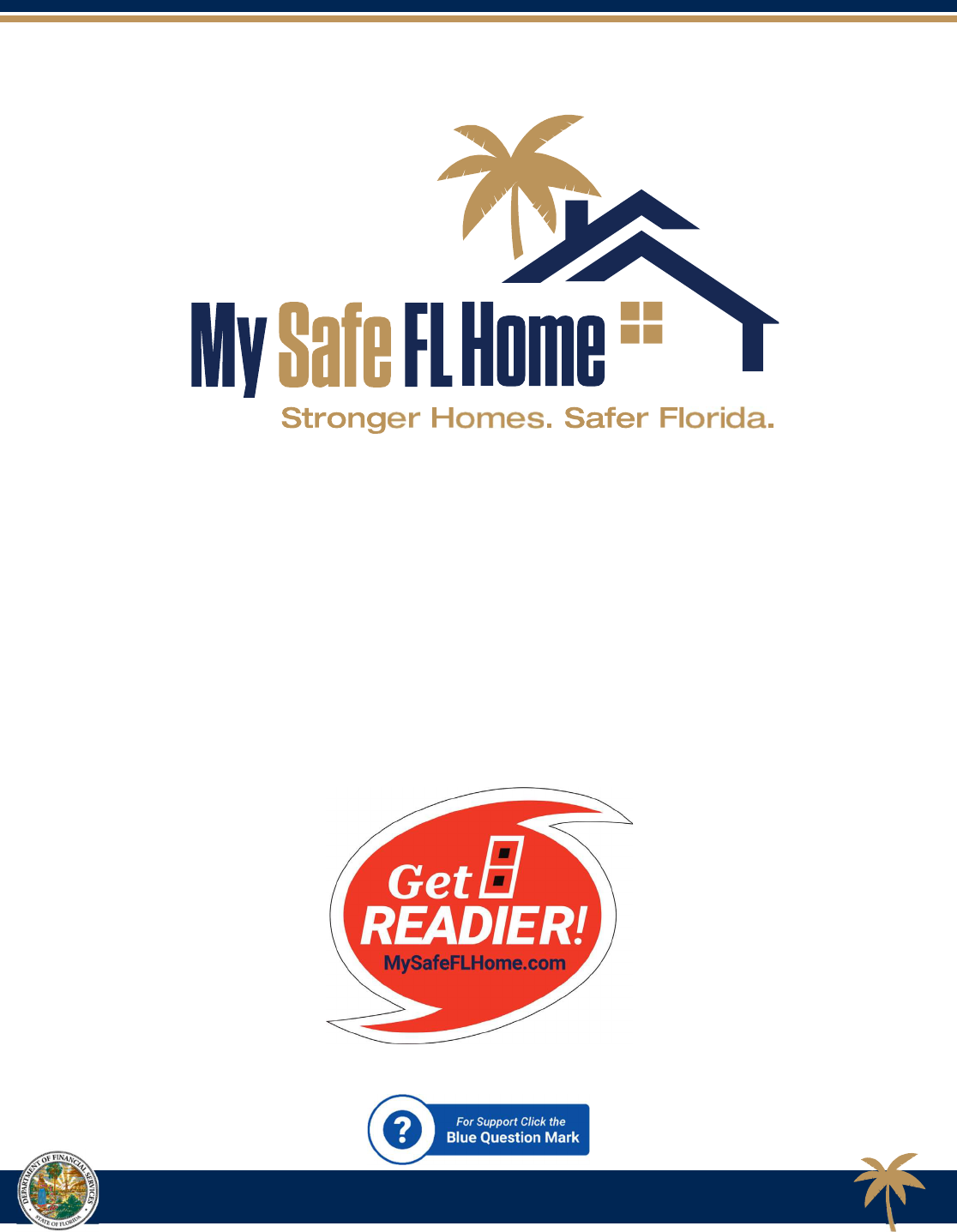
Homeowner’s
Guide
My Safe Florida Home Program
A Program Administered by the Florida Department of Financial Services
MySafeFLHome.com

Welcome
page 2
Dear Florida Homeowner,
Welcome to the Homeowner’s Guide for the My Safe Florida Home Program (Program). The Program
was recently re-enacted during a Special Session of the Florida Legislature and has two primary
components to be administered by the Department of Financial Services (DFS):
1.
Provide eligible Florida homeowners, free of charge and with no obligation, a home insp
ection that
identifies the current hurricane resistant features of their home and recommended improvements
to
further strengthen their homes against hurricane winds.
2.
Provide qualifying Florida homeowners with a grant to perform specific wind mitigation
improvements recommended by their free Program inspection to strengthen their home against
hurricanes and to save money on their Wind Insurance Premiums.
We would also like to take this opportunity to share another component of the Program available to ALL
Florida homeowners, regardless of whether they participate in the free inspection or grant components,
which is:
NO state sales tax (6%) will be charged on retail purchases of impact-resistant doors, anti-impact
resistant garage doors, and impact-resistant windows from July 1st, 2022, through June 30th, 2024.
We encourage you to review this guide before reading your free inspection report and we thank you for
your
interest in the My Safe Florida Home Program.
As of July 1
st
, 2023, changes have occurred to the program. Please review the Homeowners’ Guide in full
to see these changes.
Sincerely,
The My Safe Florida Home Program Team
A Program Administered by the Florida Department of Financial Services
MySafeFLHome.com
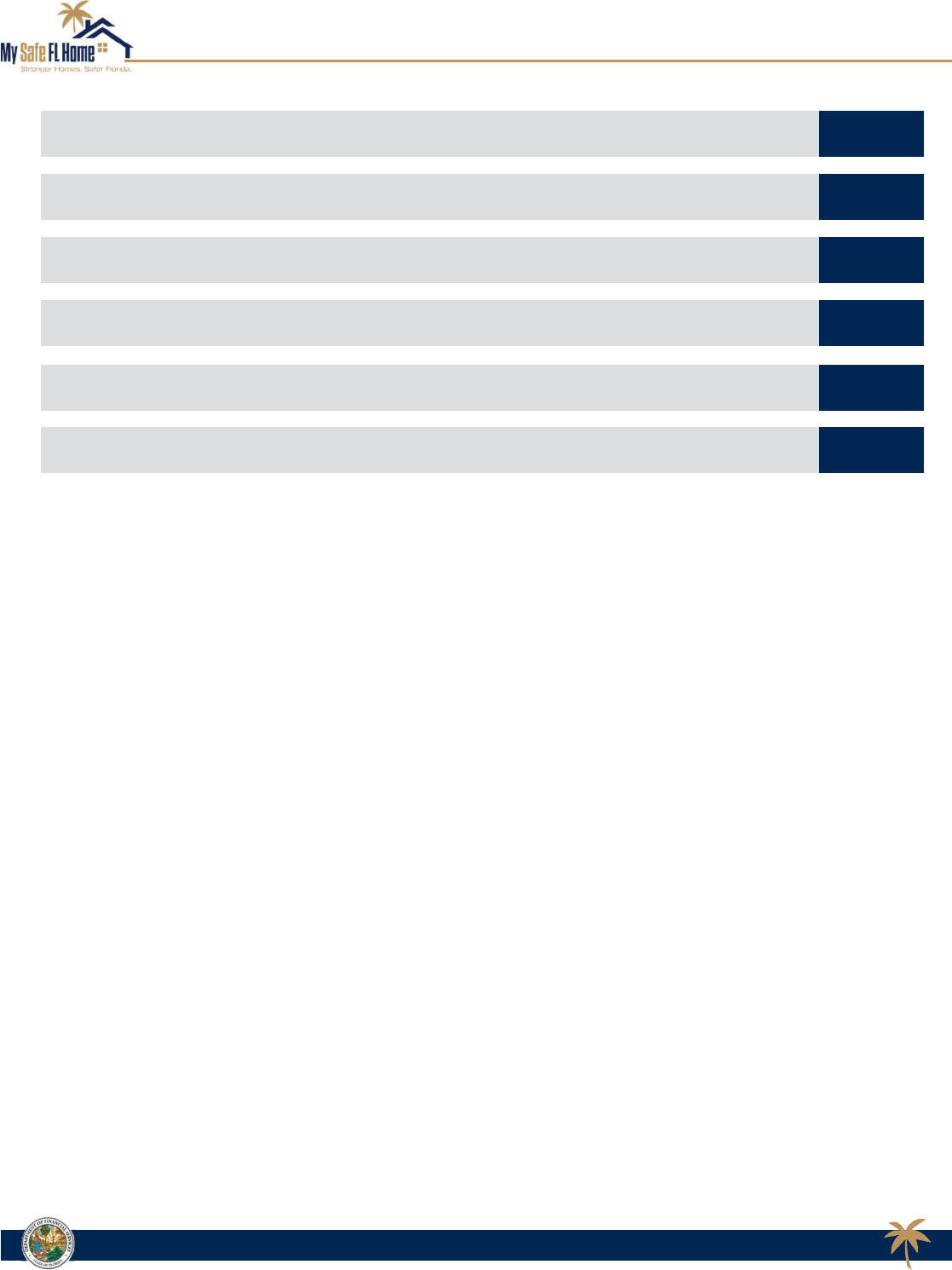
Index
page 3
A Program Administered by the Florida Department of Financial Services
MySafeFLHome.com
2
20
Glossary of Terms
18
17
Grant Reimbursements/Disbursement
20
15
Authorized Improvements Guide
12
Grant Program
11
Inspection Report
5
Free Home Inspections
4

Free Home Inspections
page 4
The Florida State Legislature has allocated $25 million through the My Safe Florida Home Program to
provide homeowners with a complete Home Hurricane Inspection at NO COST and NO OBLIGATION.
Who is Eligible to Apply for a Free Inspection?
ANY Floridian that has been granted a homestead exemption on their primary residence
is eligible to apply
for a free inspection. The primary residence must be a site-built, single-family home
(a residence constructed at its permanent location) OR a townhouse (a single-family unit
constructed in a
series or group of attached units separated by
property lines. Each townhouse shall be considered a separate
building and shall not exceed three stories in height (§ 481.203, F.S.).
Properties NOT eligible for free home inspections through the Program are:
•
Mobile Homes or Manufactured Homes
•
Condominiums or Apartments
•
Cooperative Residences
•
Multi-Family Dwellings
(duplex/triplex/quadplex)
Application Information
•
Second/Vacation Homes
•
Rental Properties
•
Uninsured Properties
•
Businesses
•
Villas
Homeowners may apply by visiting MySafeFLHome.com and clicking the Apply Now button, or going
straight to the Applicant Portal by clicking here.
To apply, homeowners are required to provide the following information:
•
Valid Email Address
•
First and Last Name
•
Home Street Address, City, and Zip Code
•
Phone Number
After Approval
Upon approval of your inspection application, the Program will notify you via email (or an alternative if
necessary) and provide you with the name and contact information of the inspection firm assigned to
inspect your home. An inspector will contact you within one week to schedule a free inspection.
Inspections typically take one hour to perform, and you should receive an email notification within two
weeks from the inspection date that your report is ready for download through the Applicant Portal. To
find your inspection report, open your case in the Applicant Portal and select the “documents” tab.
The inspection report will provide the homeowner with:
•
A summary of the current hurricane resistant features of the home and recommendations for
improvements the homeowner may take to mitigate their home against wind damage. (Please note
that the only upgrade recommendation available to townhouses is Opening Protection.)
•
Potential insurance discounts available from initial inspection and after recommended mitigation
improvements have been made.
•
A range of cost estimates regarding the recommended mitigation improvements.
Continued on Next Page
A Program Administered by the Florida Department of Financial Services
MySafeFLHome.com

Inspection Report
page 5
The purpose of your home inspection report provided through MSFH is to identify specific actions you
can take to strengthen your home against hurricane winds and to use the report as a resource to guide
you in making your home as hurricane resistant as possible.
Report Contents
Each inspection report features the following content:
Cover Page – including an exterior photo of the inspected home, street address, the Wind Certification
Entity (WCE) who prepared the report, WCE contact info, Case Number, and Inspection Date.
Table of Contents & Introduction Pages
Summary of Inspection Pages
•
Summary of Uniform Mitigation Verification Inspection Form
•
Current Hurricane Resistant Features of Your Home
•
Current Potential Savings to Your Wind Insurance Premium
•
Missing Hurricane Resistant Features of Your Home
Home Hardening Upgrades & Insurance Discount Estimates Pages
Upgrade Cost Estimates Page
Uniform Mitigation Verification Inspection Form (4) Pages – this is form OIR-B1-1802 and is often
referred
to as an ‘1802’.
Permits – previous permits connected to the home, may be provided as either an image or listing.
Inspection Photos – various interior and exterior images taken during inspection of the home.
The Next Several Pages of This Guide Provide
Some Additional Inspection Report Content Details.
Continued on Next Page
A Program Administered by the Florida Department of Financial Services
MySafeFLHome.com
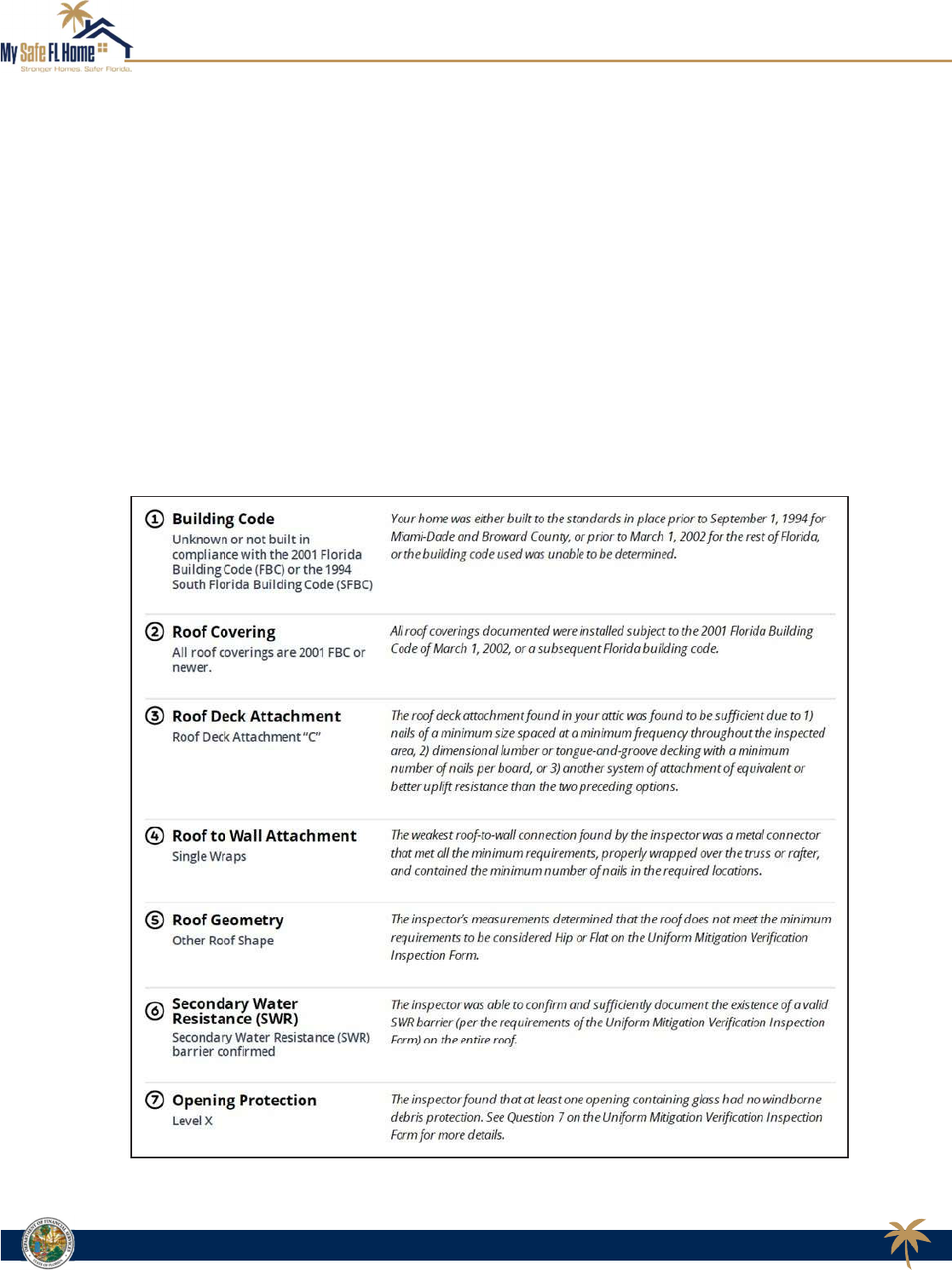
Inspection Report — Summary of Inspection
page 6
Summary of Uniform Mitigation Verification Inspection Form
This section of the report summarizes the wind mitigation features of your home observed by your
inspector and can also be found in the Uniform Mitigation Verification Inspection Form.
Your inspector will review the following:
1.
Building Code
2.
Roof Covering
3.
Roof Deck Attachment
4.
Roof-to-Wall Attachment
5.
Roof Geometry
6.
Secondary Water Resistance Barrier (SWR)
7.
Opening Protection
This page within your report is intended to provide you an at-a-glance summary of the findings
from your
wind mitigation inspection. The inspector may make recommendations based on their findings after
reviewing these features.
Here is a sample image of what this summary may look like within your report.
Continued on Next Page
A Program Administered by the Florida Department of Financial Services
MySafeFLHome.com
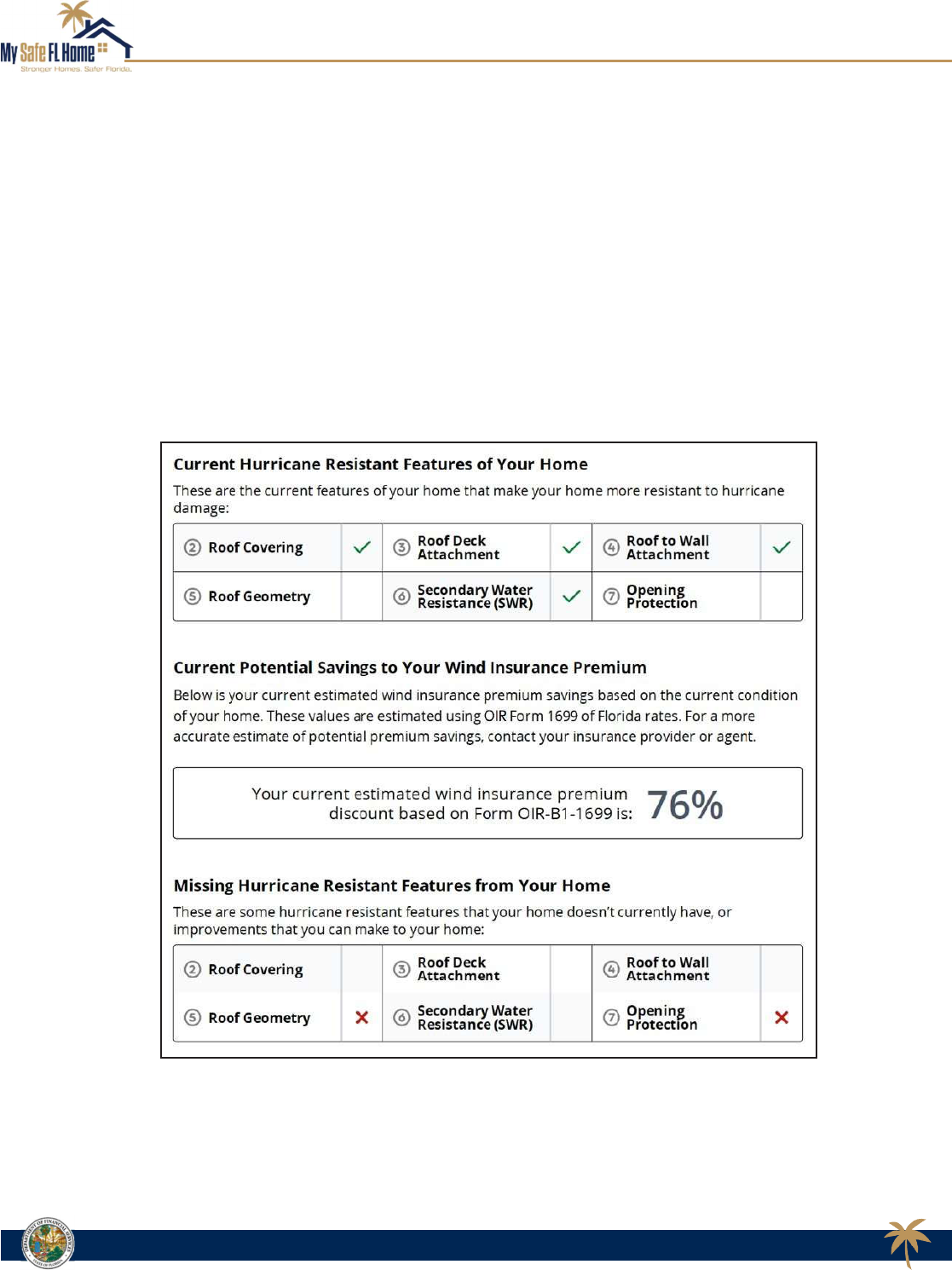
Inspection Report — Summary of Inspection
page 7
Current Hurricane Resistant Features of Your Home
Current Potential Savings to Your Wind Insurance Premium
Missing Hurricane Resistant Features of Your Home
This section of the report is contained within a single page to conveniently summarize the following:
•
Current hurricane resistant features that make your home more resistant to hurricane damage.
•
Current potential savings to your wind insurance premium based on the current hurricane resistant
features of your home.
•
Wind mitigation features that could be implemented to harden your home against hurricanes. These
improvements may result in wind insurance premium discounts from your insurer.
Here is a sample image of what this summary may look like within your report.
PLEASE NOTE: Although ‘Roof Geometry’ is considered a hurricane resistant feature for Florida homes
and specific shapes can provide savings for wind insurance premiums, making any improvements to the
geometry of your roof are NOT covered through the My Safe Florida Home Grant Program.
Continued on Next Page
A Program Administered by the Florida Department of Financial Services
MySafeFLHome.com
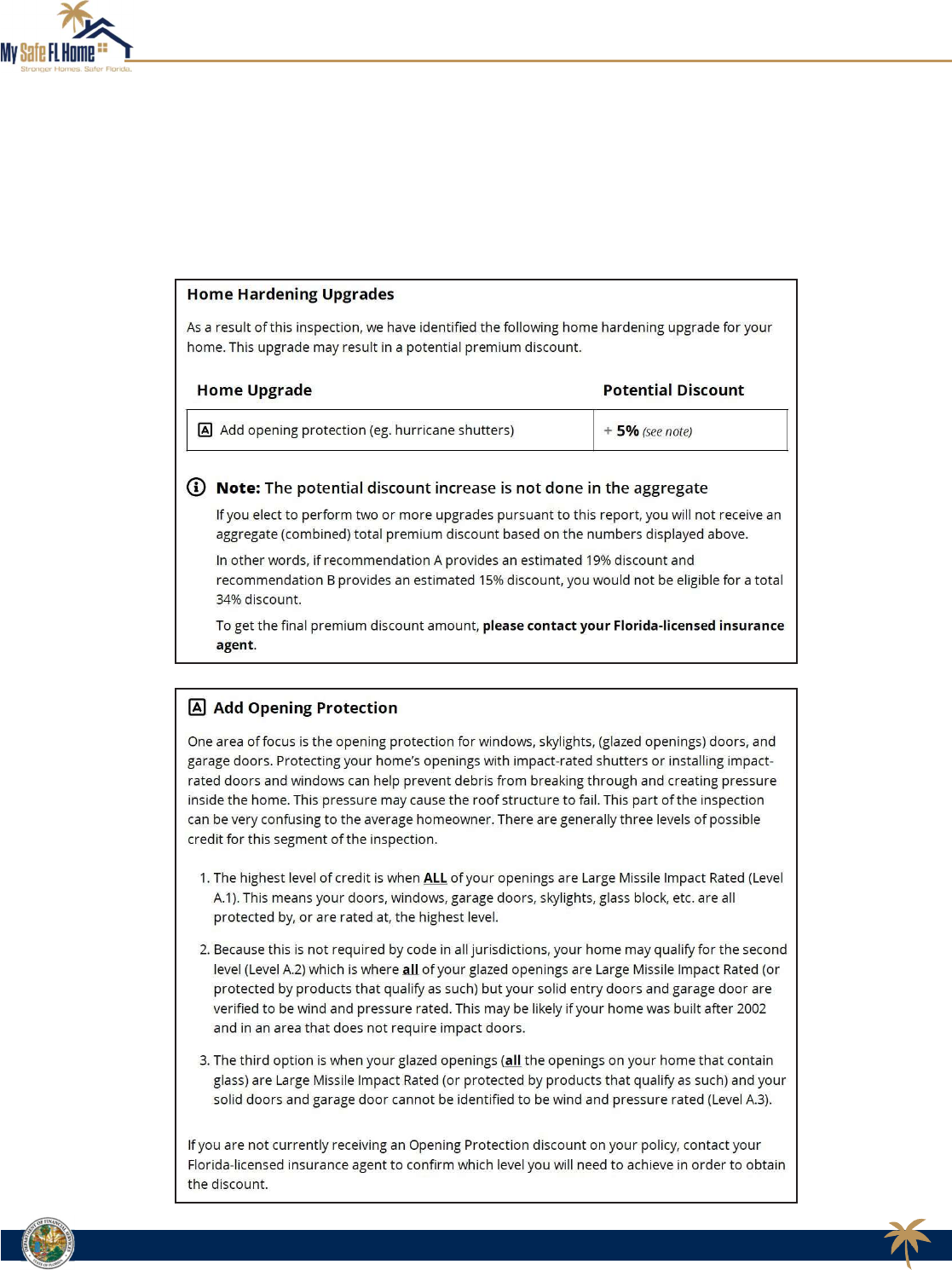
Inspection Report — Summary of Inspection
page 8
Home Hardening Upgrades & Insurance Discount Estimates Pages
One of the key components of this report is to identify potential upgrades to mitigate wind damage
to your home. These types of improvements may result in wind insurance premium discounts
from
your insurer. Townhouses, as defined in § 481.203, F.S., may only receive recommendations
for
opening protection.
Here is a sample image of what this summary may look like within your report.
Continued on Next Page
A Program Administered by the Florida Department of Financial Services
MySafeFLHome.com
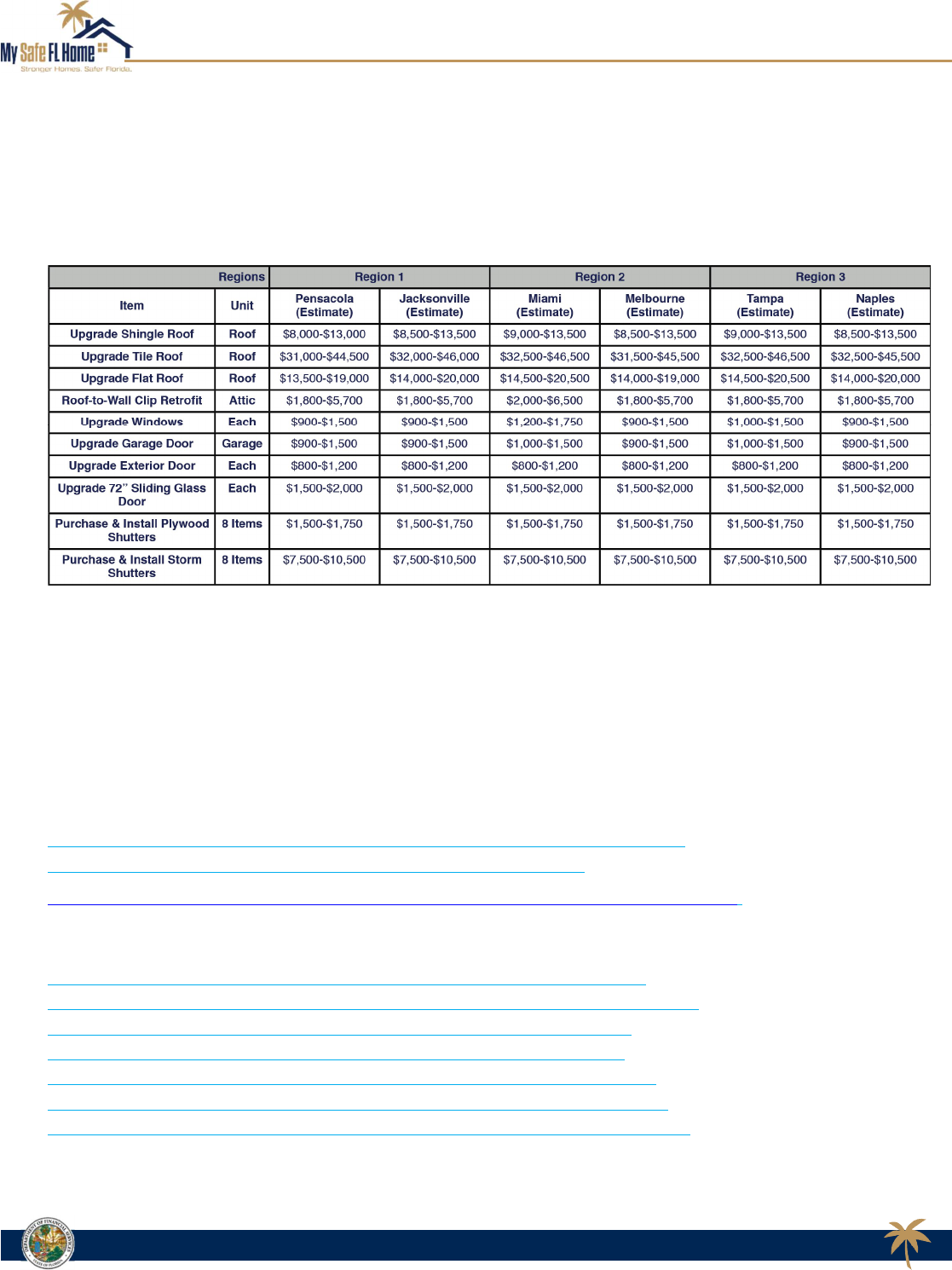
Inspection Report — Upgrade Cost Estimates
page 9
Each home inspection report contains a price range reference guide for typical wind mitigation upgrades
in multiple wind-borne regions based on a 3 Bedroom, 2 Bath, 1,750 square foot home with 400 square
foot
garage that is approximately 30 years old. It is important to keep in mind that individual prices can vary
substantially from these ranges provided in your report due to various factors such as home
location,
availability of materials, labor costs, and in
flation. We recommend that several bids be obtained from
Program Contractors for any wind mitigation upgrades you are considering for your home.
PLEASE NOTE: Items listed above may not be applicable to your report.
This chart is being provided for illustration purposes only.
Please
review
your
report
to
see
which
items
are
applicable.
Sources
Rounded pricing estimates were made possible through the use of Homewyse.com on 11/15/2022. Please
use their website to review more specific zip code pricing. Roof-to-Wall Clip Retrofit cost estimate range
is
provided by Florida Retrofits.
Roofing Material
https://www.homewyse.com/services/cost_to_install_asphalt_shingle_roof.html
https://www.homewyse.com/services/cost_to_install_tile_roof.html
https://www.homewyse.com/services/cost_to_install_membrane_roofing_system.html
Windows/Doors
https://www.homewyse.com/services/cost_to_install_storm_windows.html
https://www.homewyse.com/services/cost_to_install_replacement_windows.html
https://www.homewyse.com/services/cost_to_replace_garage_door.html
https://www.homewyse.com/services/cost_to_install_exterior_door.html
https://www.homewyse.com/costs/cost_of_replacement_sliding_doors.html
https://www.homewyse.com/services/cost_to_install_hurricane_shutters.html
https://www.homewyse.com/maintenance_costs/cost_to_boardup_window.html
Continued on Next Page
A Program Administered by the Florida Department of Financial Services
MySafeFLHome.com

Inspection Report — Checklist
page 10
We’ve created the following checklist to help you get the most out of your inspection report.
1. Review the information on the Summary of Inspection page and familiarize yourself with the current
and missing hurricane resistant features of your home, along with the potential savings you may
receive on your wind insurance premium for your current features.
2. Review the information on the Home Upgrades
pages and familiarize yourself with the
improvements that are being recommended for your home and potential discounts you may
receive
on your wind insurance premium from your insurance provider.
3. Contact your insurance provider to verify the potential premium discount savings you may receive
for the current hurricane resistant features of your home and for making the recommended
hurricane
resistant improvements to your home.
4. Review the information on the Upgrade Cost Estimates page and consider the estimated cost
ranges
for the recommended improvements in your inspection report while keeping in mind that actual
costs will vary based on location, labor, and material costs.
5. Decide which of the recommended improvement(s) to move forward with on your home.
6. If you believe you meet the eligibility requirements, login to the Applicant Portal
and apply for the
grant component of the Program. Please note that if you’re approved for a grant, you MUST select
from a list of approved Program Contractors within the Applicant Portal to complete the work on
your home. If you’re NOT approved for a grant, you may still access this list by clicking here to locate
a contractor or go with one of your own choosing. Regardless of your
approval for a grant, we
recommend the remaining checklist items be followed.
Approval for a grant does not guarantee
funding. You must still provide additional information after improvements have been made.
After
you provide the draw documentation, the Program will determine your eligibility for funding.
7. It is recommended, but not required, that you request up to three bids from contractors
on the
approved MSFH contractor list for the improvement work.
8. Review the bids carefully and select an approved MSFH contractor.
You may select more than one
contractor from the approved MSFH contractor list.
9. Before signing any contracts, confirm that the selected contractor is on the approved list,
will obtain all
necessary permits, and is aware of all program requirements.
Prior to beginning work, you must
ensure the contractor receives all applicable building permits from the local building inspector’s
office. At the end of construction, you must also ensure the permits are closed out and the local
building in
spector’s office has completed all required inspections. Afterwards, you should request
the Final Inspection from the MSFH Program to continue the grant application process.
10. After work is completed, you must make your home available for a final inspection before payment
will be disbursed.
Continued on Next Page
A Program Administered by the Florida Department of Financial Services
MySafeFLHome.com

Grant Program
page 11
The Florida State Legislature has allocated
grant money to qualifying Florida homeowners who have
received their free home inspection through the Program and have decided to make eligible wind mitigation
improvements that were recommended in their inspection report.
According to § 215.5586(2)(b), F.S., “All grants must be matched on the basis of $1 provided
by the
applicant for $2 provided by the state, up to a maximum state contribution of $10,000 toward
the actual
cost of the mitigation project.” In other words, the homeowner must
contribute funds equal to 1/3 of the
cost of the project toward the project to be reimbursed for the remaining 2/3s,
up to a maximum state
contribution of $10,000.
Grants are only dispersed AFTER the work has been completed by an approved Program Contractor, the
work has been re-
inspected by the Program, and payment has been made in full for the work by the
homeowner.
Low-Income (LI) homeowners as defined under § 420.0004 (11), F.S., and who meet all other grant
application requirements are eligible for a grant of $10
,000 and are not required to provide a matching
amount.
PLEASE NOTE: Not all applicants who have received an inspection through the MSFH program
will be
eligible for a grant.
When recommended by a hurricane mitigation inspection, grants for townhouses, as
defined in § 481.203, F.S., may only be used for opening protection.
Who Is Eligible To Apply For The Grant Program?
The following criteria will be used to review grant applications:
•
You must have applied for, been approved for, and have received a free home hurricane inspection
through the Program.
•
You must provide proof of homestead exemption. If you need assistance obtaining a copy of your
homestead exemption information, please confer with your local Property Appraiser or Tax
Collectors
Office.
•
You must provide insurance documentation that your home has an insured value of $700,000 or less
and a copy of your current property insurance declarations page. If you do not have a copy, contact
your home insurance company. Applicants participating in the Low-Income grant do not need to
provide proof of the home’s insured value.
•
The initial building construction permit for the home must have been issued prior to January 1, 2008.
If you do not know when your home was built, please contact your local officials. This information is
frequently available through the website or office of your Property Appraiser.
•
Homeowners must make their home available for a final inspection after construction work has been
completed. This final inspection is provided at no cost to the homeowner.
How To Apply & Approval Information
You must apply through the Applicant Portal by clicking here and logging into your account.
Applications are
reviewed in the order they are received and noti
fication will be sent to you via email within two weeks on the
approval status of your application.
Homeowners who have not received any recommendations for upgrades will not be able to utilize a grant
and therefore will not be approved. The approved MSFH contractor list
will be available in a grant approval
email.
Continued on Next Page
A Program Administered by the Florida Department of Financial Services
MySafeFLHome.com

Authorized Improvements Guide
page 12
Please read this guide carefully.
Only the improvements recommended in your inspection report will
be authorized for reimbursement.
No other improvements are authorized under the program. To provide
a better understanding of the five authorized improvements covered by the
My Safe Florida Home
Program, we have listed them below with detailed descriptions. Please note that
when recommended
by a hurricane mitigation inspection, grants for townhouses, as defined in § 481.203, F.S.,
may only be
used for opening protection.
Improvement 1– Improving the strength of your roof deck attachment.
If your roof consists of shingles nailed to plywood sheets, the inspection may reveal that the plywood
sheets are not adequately nailed to your roof trusses, and additional nails or longer nails need to be
added to reduce the possibility of the plywood being blown off in a hurricane.
Improvement 2 – Reinforcing roof-to-wall connections.
Completed by installing metal tie-down clips that attach roof rafters to walls to reduce the possibility
that all or a portion of your roof will lift off your house during a hurricane.
Improvement 3 – Creating a secondary water barrier to prevent water intrusion.
When adding a Secondary Water-
Resistant Barrier (SWR), you may use program funds to replace your
roof if the final product result includes the SWR. Please remember that the program will only provide up
to $10,000.
There are three ways to accomplish a SWR:
At the time of reroofing your home, use a full-coverage self-adhered underlayment,
commonly
referred as peel-and-stick, directly to the roof deck material;
At time of reroofing your home, use a self-adhere product commonly referred to as sea
m tape on all
joints and seams of the roof decking material. This still requires a nailed down underlayment such
as felt paper; or
If you are not replacing the roof, install a foam adhesive on all the seams and joints from the attic
side of your roof.
Costs relating to re-
covering your roof after adding the SWR are covered by the grant. Improving the
survivability of your roof covering might include upgrading to stronger hurricane-
resistant roof shingles,
attached with properly sized and properly applied roo
fing nails, to reduce the susceptibility of your roof
shingles blowing off in a hurricane. You may replace your roof with a different covering of your choice
like tile, metal, or shingle. DO NOT upgrade your roof covering without also adding SWR. You mus
t
replace all portions of a contiguous roof with SWR. MSFH funds shall not be used for roof patching or
other partial repairs of the roof.
Improvement 4 – Opening Protection (Windows)
Completed by installing impact windows or hurricane shutters.
When recommended by a hurricane
mitigation inspection, grants for townhouses, as defined in § 481.203, F.S.,
may only be used for opening
protection.
Continued on Next Page
A Program Administered by the Florida Department of Financial Services
MySafeFLHome.com

Authorized Improvements Guide
page 13
Continued on Next Page
A Program Administered by the Florida Department of Financial Services
MySafeFLHome.com
PLEASE NOTE:
If a homeowner currently has compliant hurricane shutters, but requests grant funds for
impact windows instead, the request will be denied. A home with compliant shutters
has already been
mitigated against wind damage. The grant cannot be used to exchange one type of protection for another.
Improvement 5 – Opening Protection Exterior Doors (Including Garage Doors)
Completed by installing hurricane-rated doors or replacing a standard garage door with a hurricane-
rated
garage door.
When recommended by a hurricane mitigation inspection, grants for townhouses, as defined in
§ 481.203, F.S.., may only be used for opening protection.
a) If a homeowner currently has unprotected pedestrian or garage doors that include
glass, the grant may be approved to replace the door with an impact door (or
shutter the door with an impact-tested product).
b) If a homeowner currently has pedestrian or garage doors that are solid (no glass)
and not protected, the request to replace or shutter the door with an impact-tested
product will be denied unless a recommendation is included in their inspection report.*
*Exception: An exception to the prohibition on replacing a solid door can be made IF the homeowner can provide documenta
tion
from their insurance agent that replacing all solid doors and/or garage doors with upgraded impact-
tested products will result in
a discount on their insurance premium.
Documentation required for the above exception can be one of the following: an email, letter, or quote from
insurance agent. This
documentation must be uploaded to the grant portal when
requesting reimbursement. The documentation must specifically
mention that a rating of A.1 on the windstorm mitigation form OIR-B1-1802 is required to obtain the
discount on the policy
currently in force, and the amount of any potential savings if A.1
is achieved. Once this documentation is received, the replacement
of a solid door can be approved.
Improvements 4 and 5 are often combined because it is recommended that they be undertaken together.
NOTE: There are three levels of opening protection under Improvement 5. They are:
Improvement Standard – The lowest-cost option for protecting window openings. On a one-
story
house, this improvement would p
rovide temporary structural panels for each window that would
need to be installed each time a serious storm threatened the home. On a two-
story home, this
improvement would be a combination of standard shutters (first floor) and permanently attached
shutters (second floor).
Improvement Permanently Attached – Protective devices that are permanently attached to the
house and are deployed when a hurricane is approaching.
Improvement Permanently Deployed – These are protective devices such as impact-rated glass
windows and doors or hurricane screens that require no installation when a hurricane is
approaching.
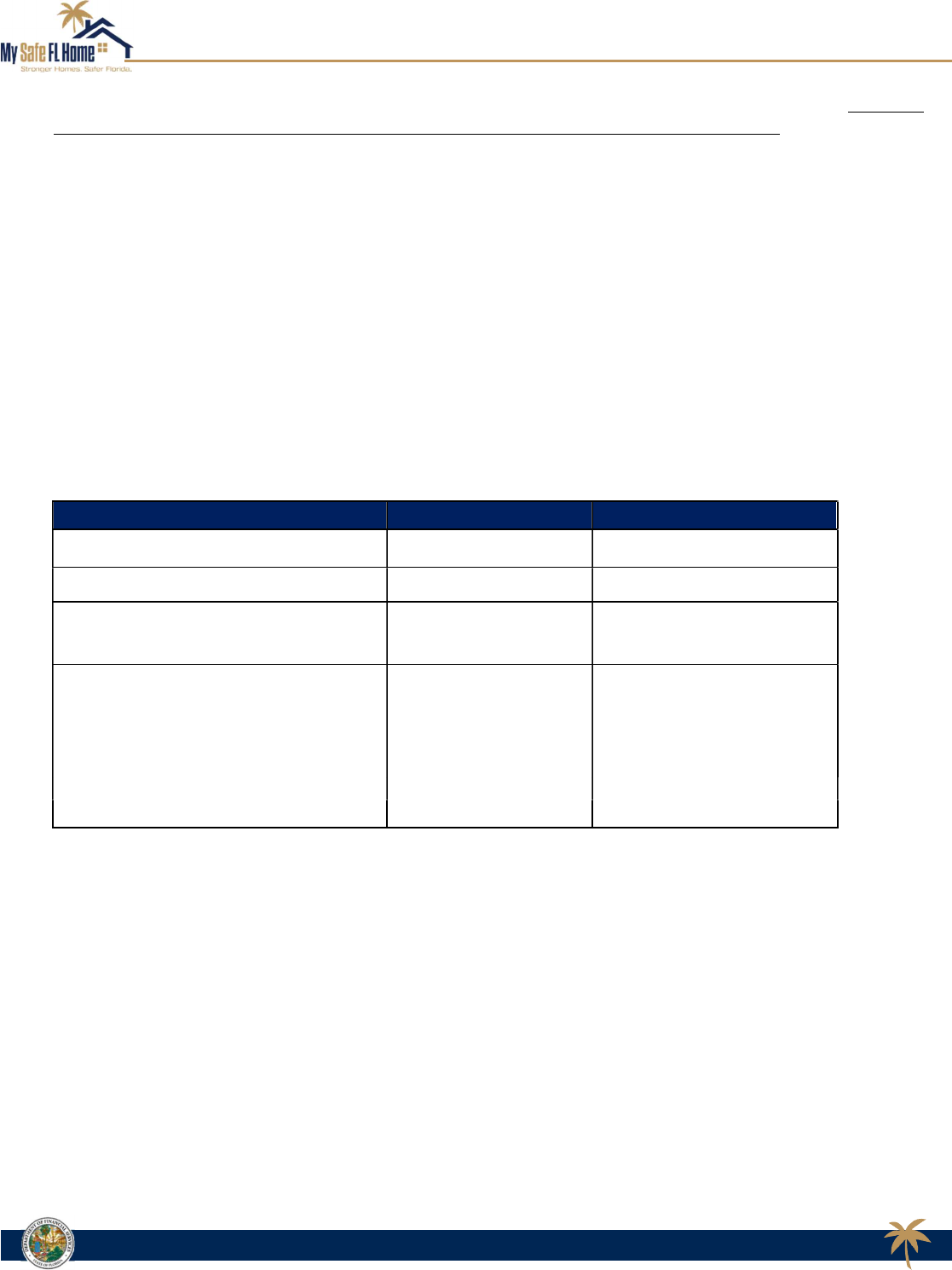
Authorized Improvements Guide
page 14
Continued on Next Page
A Program Administered by the Florida Department of Financial Services
MySafeFLHome.com
PLEASE NOTE: Approval of your grant application does not guarantee a disbursement of funds.
Grantees
must follow all the guidelines required for reimbursement or payment to the contractor.
Those guidelines
include:
Homeowners MUST use an approved contractor from the authorized list.
Homeowners MUST comply with all Program requirements.
Approval of a Draw Request will be contingent upon receipt of uploaded required documentation. If a
draw request does not contain all
necessary documents or information, it will be returned to the
applicant so they can correct the missing information.
Final Inspection MUST BE COMPLETED to verify that all the improvements were made.
After your final inspection is complete and entered into the system, you can return to
the grant portal to
submit all information required for the funding that would be covered in your approved grant.
Please recall
that for Matching Grants, the homeowner must contribute funds equal to 1/3 of the cost of the p
roject
toward the project to be reimbursed for the remaining 2/3’s,
up to a maximum state contribution of
$10,000.
Documents Required for Draw Reimbursement Request
Reimbursement Documentation
Homeowner – Regular
Contractor – Low Income
Invoice Cover Sheet
Yes
Yes
Original Contractor Invoice(s)
Yes
Yes
Proof of Payment (cancelled check,
receipts, paid invoice)
Yes
N/A
Insurance proof of premium discounts
(email, letter, new quote from insurance
agent that outlines what, if any,
discount is available)
Yes
Yes – homeowner will be
responsible for uploading
this information.
**Initial and final inspection reports are also required but already stored in the grants portal and are
not
the applicant’s responsibility to provide.
***If the applicant chose to replace a solid door without a recommendation in an inspection report, this
document must be provided for Reimbursement. An email, letter or quote from an insurance
agency/compan
y requesting upgrade to change rating to A.1 as required in Form 1802 to obtain
discount.
This requirement is applicable to all counties except Broward & Dade Counties which will be
exempt due to the Citizens Rate Guidelines Schedule for Wind Mitigation Di
scounts. Contractors must
request this information from Low Income applicants for payment disbursement.

Grant Reimbursements or Disbursements
page 15
Contractor Confirmation and Requesting a Final Inspection
After receiving an Initial Inspection Report from an MSFH program-
assigned inspector, a grant application will
open in the Applicant portal. You can access the applicant portal via mysafeflhome.com at any time.
After the
grant application is submitted, reviewed, and approved, you
will receive an approval email with instructions on
how to move forward.
After receiving an approval email for a Matching or Low-
Income grant, you are free to request quotes from up
to three (3) approved contractors. The approved MSFH contractor list will be available in a grant approval email.
When you receive grant approval, grant money is set aside for you. Please keep in mind that the final inspection
(the step to initiate the Reimbursement process) must be completed within one (1) year of your
approval date
OR before July 1st, 2024 (whichever is sooner). After one (1) year, you may apply for an extension of time
, but
funding is limited and the MSFH Program cannot guarantee future approvals. Each homeowner may receive
only one grant.
Please review your initial inspection report carefully. The only work that is authorized is that
listed in the
Authorized Improvements Guide and must be supported by a recommendation in your initial inspection report.
If you have any questions about what is recommen
ded in your report, please contact your WCE (inspection
company) using the contact information in your Inspection Approval email.
Important Notice
: Work performed that is NOT recommended on your initial inspection report WILL NOT be
reimbursed.
Once you
have selected a contractor, you will need to assign that contractor to your case through the Applicant
Portal. All applicants, both Low-
Income (LI) and Matching grant applicants must do this prior to beginning
work. If this step was not available to you at
the time of approval and you have already begun work, please add
your contractor as soon as possible.
You will need to enter all
requested information in the Contractor Confirmation step. Please ensure you enter
your contractor’s information as it appears in the approved MSFH contractor list. The contractor’s ID number
is the three-to-four digit code next to their name.
Important Notice: While both types of Applicants will need to complete the step, only Low-
Income applicants’
cases will appear in their contractor’s portal.
After you have clicked “Complete and Submit”, your status will change to “Contractor Confirmation Submitte
d.”
You will not need to
perform any other actions in the Applicant Portal until after the work on your home is
complete. If you selected a contractor that was not on the list, you will receive an email notification that you
will need to select a different contractor.
Important Notice
: The MSFH Program will not make any grant payments if you fail to use an approved
contractor to perform approved work or otherwise do not follow Program requirements.
Prior to beginning work, you must ensure the contractor
receives all applicable building permits from the local
building inspector’s office. At the end of construction, you must also ensure the permits are closed out and the
local building inspector’s office has completed all required inspections. Afterwards,
you should request the
Final Inspection from the MSFH Program.
Continued on Next Page
A Program Administered by the Florida Department of Financial Services
MySafeFLHome.com
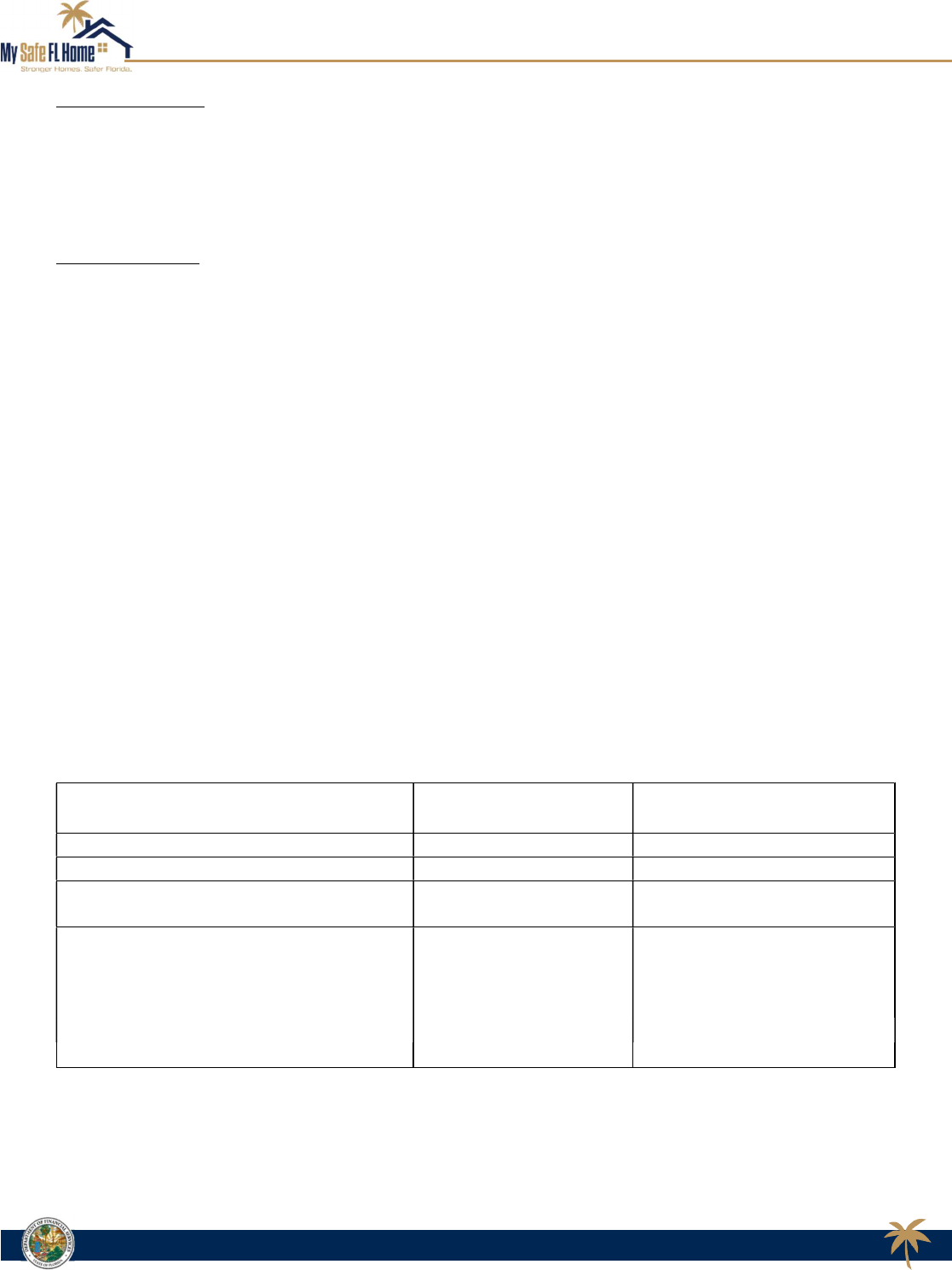
Grant Reimbursements or Disbursements
page 16
Important Notice: Do not request a Final Inspection until all work on your home has been
completed. You
have only one opportunity to request a final inspection.
When work on your home is complete, you must initiate the Reimbursement or
Disbursement process for
BOTH types of grants by having your home inspected again. By participating in the program, you agreed to
make your home available for a final inspection.
Important Notice: There is no other way to initiate the Reimbursement or
Disbursement process without
requesting a Final Inspection from the My Safe Florida Home program via the Applicant Portal.
After you have requested your Final Inspection, a case manager
will alert your WCE (your inspection
company) and will send a notification similar to the Initial Inspection Approval email. Even though WCEs will
prioritize Final Inspection requests over initial and Quality Control (QC) inspection requests, inspections w
ill
be scheduled based on a queue.
Once your Final Inspection has been completed, the WCE will submit the Final Inspection Report to the MSFH
portal. After your status has changed to “Pending Reimbursement Request”, if you are a Matching Grant
recipient, you are ready to provide additional information through the Applicant Portal for Reimbursement.
If you are an Low-Income Grant recipient,
you will need to return to the portal to upload an email, letter, or
new quote from your insurance agent that outline
s what, if any, discount is available, but it is the contractor’s
responsibility to request payment from the Program portal and provide all relevant documents.
Below is a list of the documents required for a Reimbursement Draw Request. Contractors should refer to
the Contractor Manual for information on completing a draw request for Low-
Income cases. To receive the
insurance proof of premium discount documentation, you will need to send your Final Inspection Report to
your insurance agent.
Continued on Next Page
A Program Administered by the Florida Department of Financial Services
MySafeFLHome.com
Documents Required for Draw Reimbursement Request
Reimbursement Documentation Homeowner –
Matching $10,000
Contractor – Low Income
$10,000.00
Invoice Cover Sheet Yes Yes
Original Contractor Invoice(s) Yes Yes
Proof of Payment (Cancelled check,
receipts, paid invoice)
Yes N/A
Insurance proof of premium discounts
(email, letter, new quote from insurance
agent that outlines what, if any, discount is
available)
Yes Yes – the homeowner will be
responsible for uploading this
information.
**Initial and final inspection reports are already stored in the grants portal and are not the applicant’s responsibility to provide.
***If the applicant chose to replace a solid door without a recommendation in an inspection report, this document must be
provided for Reimbursement. An email, letter, or quote from an insurance agency or company requesting upgrade to change the
rating to A.1 as required in Form 1802 to obtain an insurance discount. This requirement is applicable to all counties except
Broward & Dade Counties which will be exempt. Contractors must request this information from Low-Income applicants for
payment disbursement.
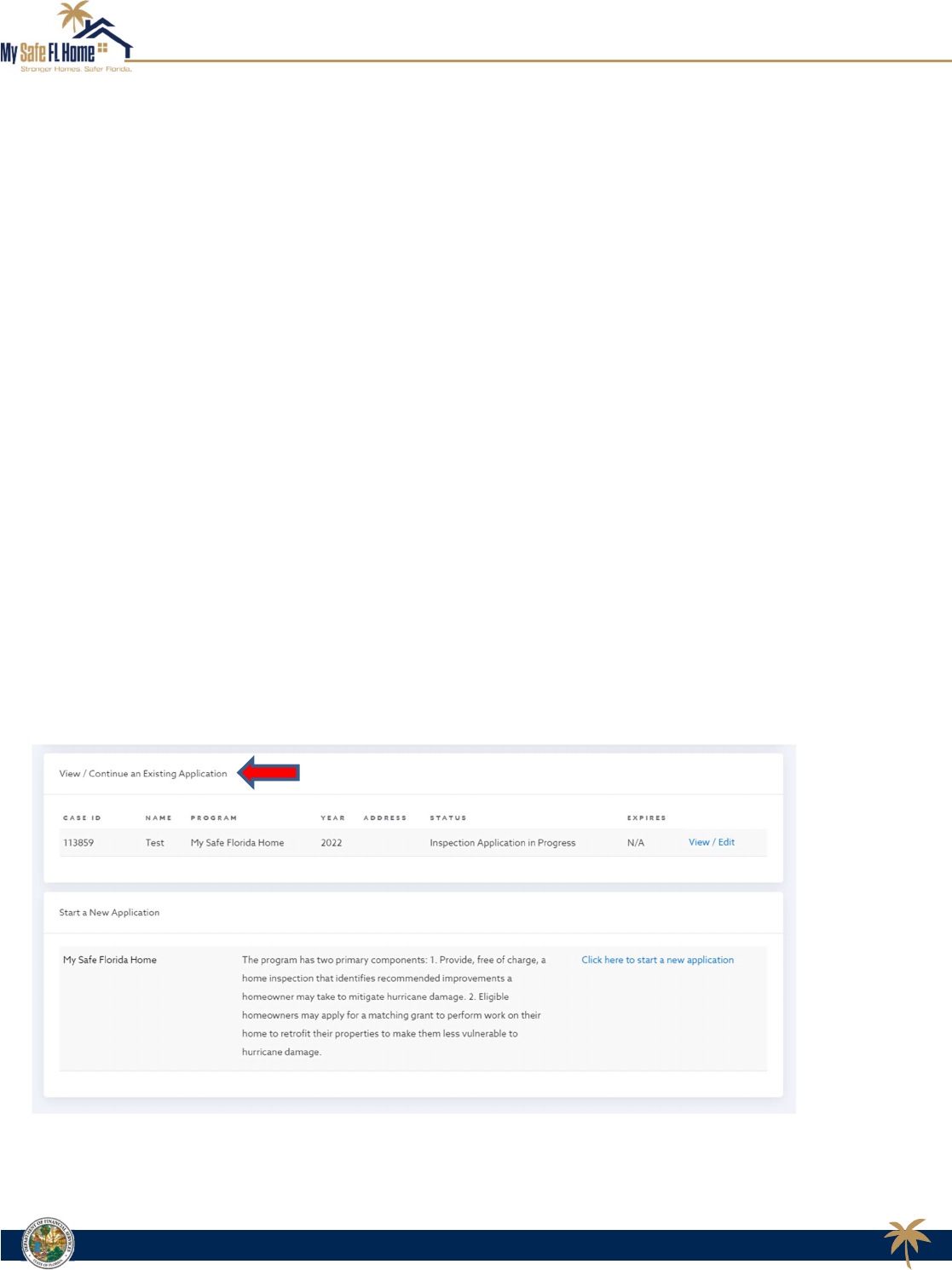
Grant Reimbursements
page 17
Draw Request Quick Tips
If there is an issue with your Reimbursement Draw Request, the request will be returned to you. Please
check for emails from no-reply@mysafeflhome.com.
The following things will speed up the processing of your Draw Request.
Submitting all required documents (including proof of premium discounts)
Labelling the documents
Ensuring the Matching Grant Cover Sheet and Original Contractor Invoices have corresponding
costs
Submitting .pdf, .jpg, or .png files
The following things may slow down the processing of your Draw Request.
Submitting more documents than are required
Submitting duplicate documents
Submitting files that cannot be opened
Requesting Reimbursement
Once an application is moved to the “Final Insp Complete – Pending Reimbursement Request” status, the
application will move into the “Grants” section of your portal’s home screen.
Caption: View within the Applicant Portal prior to “Final Inspection Complete – Pending Reimbursement Request”
status. Note that the main heading says “View/Continue an Existing Application.
Continued on Next Page
A Program Administered by the Florida Department of Financial Services
MySafeFLHome.com
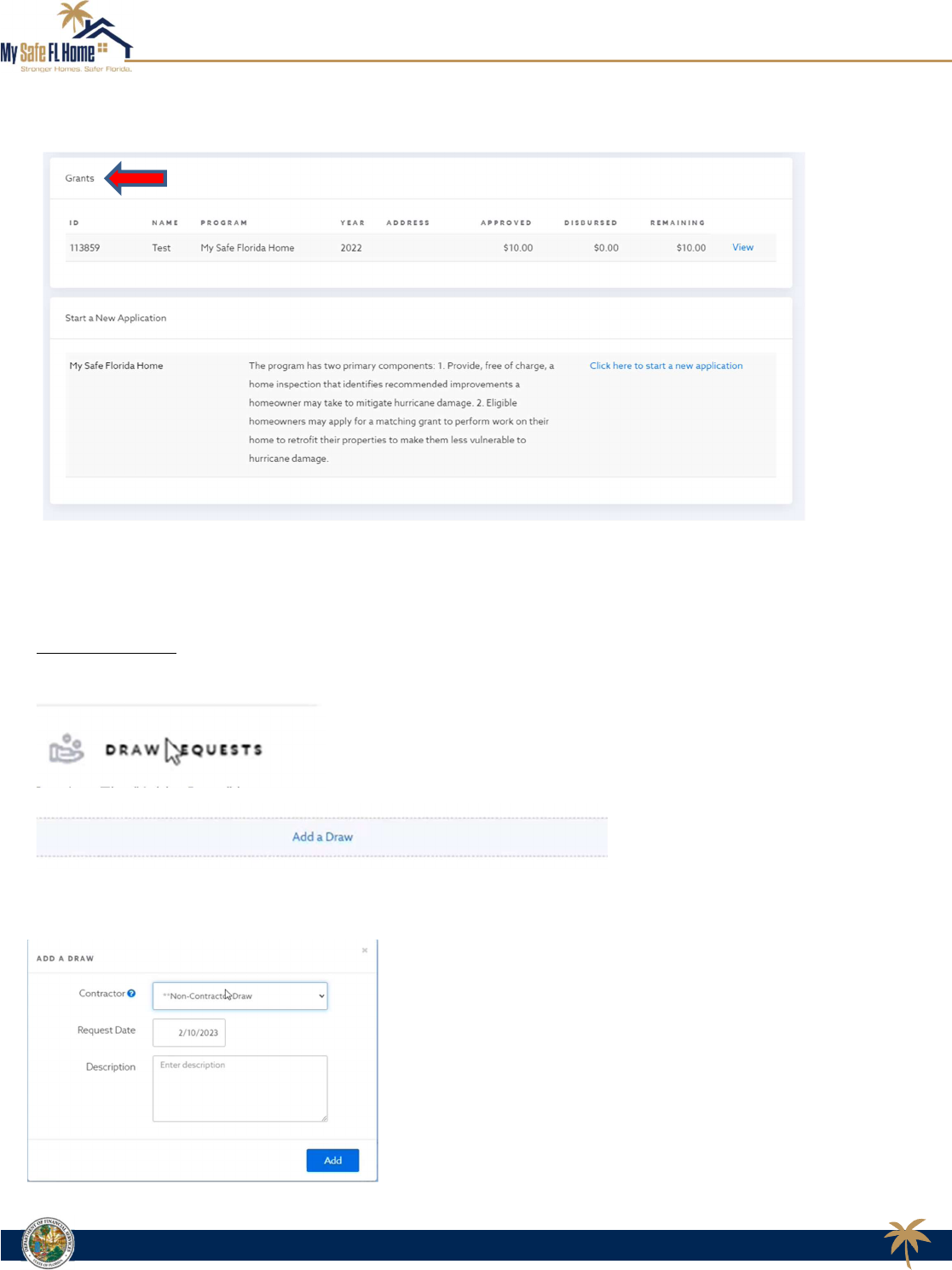
Grant Reimbursements
page 18
Caption: View within the Applicant Portal after the case is moved to the “Final Insp Complete – Pending
Reimbursement Request” status. Note that the main heading says “Grants”.
Continued on Next Page
A Program Administered by the Florida Department of Financial Services
MySafeFLHome.com
All the documents listed within the Documents Required for Draw Reimbursement Request
table will be
provided in a Draw Request in the system. Click the “Draw Requests” tab within your case, then select “Add
a Draw”.
Important notice: Low-Income applicants will not need to take this step as it is the contractor’s
responsibility.
Caption: The “Add a Draw” button
You will first be required to enter a name, date, and description of your request. Ensure you select “Non-
Contractor
Draw”. You will be required to enter a description. Please add “Reimbursement Request” to this field. Select “Add.”
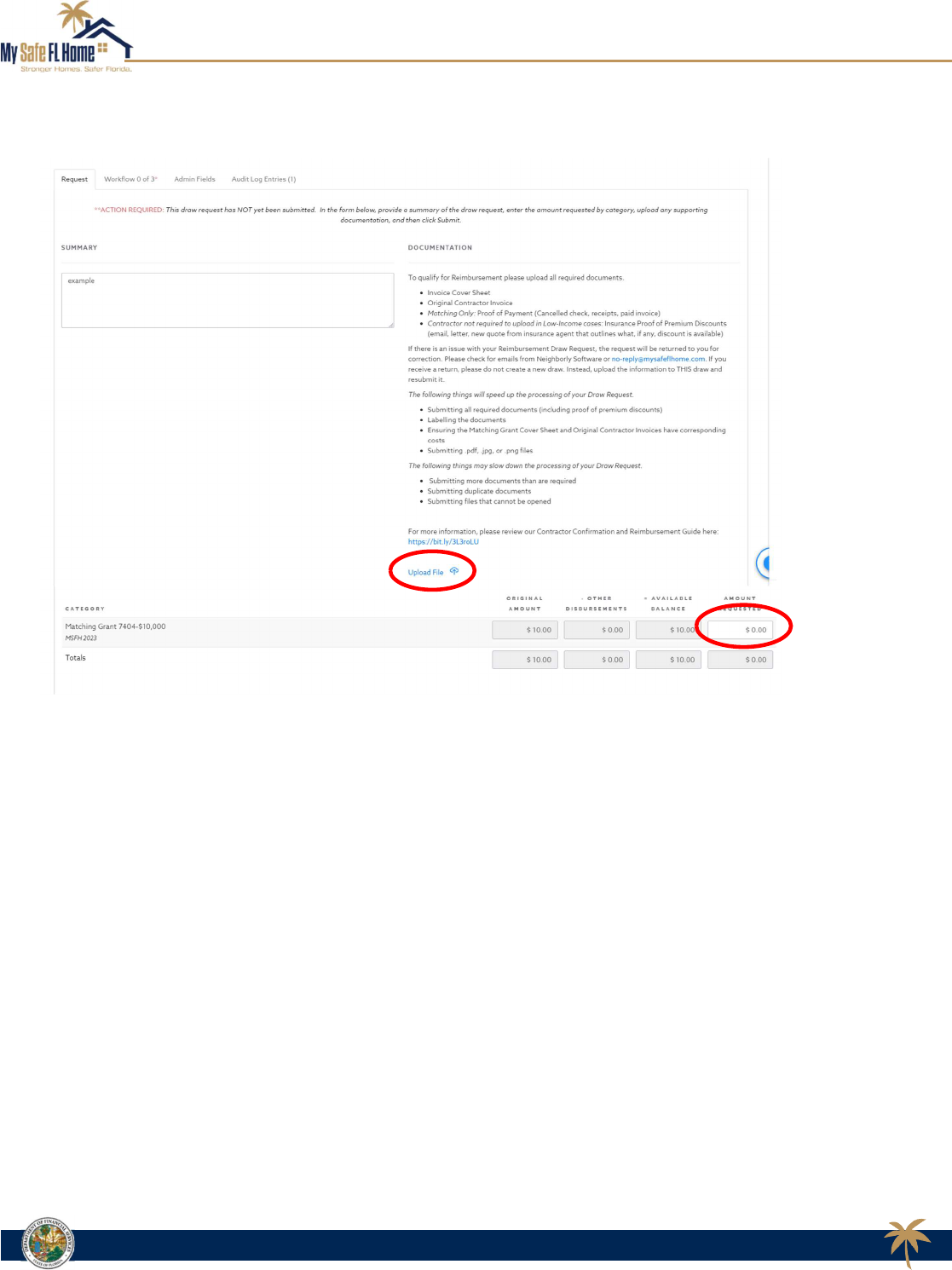
Grant Reimbursements
page 19
Continued on Next Page
A Program Administered by the Florida Department of Financial Services
MySafeFLHome.com
In this part of the
screen, you may upload your required documents using the blue “Upload File” button pictured
under the “Documentation” header and list.
You will also need to add the amount you are requesting to the box
with the white background in the bottom righthand corner.
Please remember that for a Matching grant, according to Florida Statute 215.5586, 2(b),
“All grants must be
matched on the basis of $1 provided by the applicant for $2 provided by the state up to a maximum state
contribution of $10,000 toward the a
ctual cost of the mitigation project.” In other words, Matching grant
recipients must contribute funds equal to 1/3 of the cost of the project toward the project to be Reimbursed for
the remaining 2/3s up to a maximum state contribution of $10,000.
For example, if an applicant were to pay $15,000 for new impact-
rated windows, their required contribution
would be $5,000, and the state’s contribution would be equal to the maximum grant amount of $10,000. If the
windows cost $9,000, the applicant would pay $
3,000 and would receive a state matched Reimbursement of
$6,000. If the windows cost more than $15,000, the applicant would still only receive $10,000, as that is the
maximum Reimbursement amount.
After you have entered all the required information, you will be able to submit your request. If approved, you will
receive an email notification from Neighborly Software and a check will arrive in the mail in the following weeks.
If there is a problem wit
h your Reimbursement request, you will receive an email notification with details as to
why; and you will have opportunities to correct the information and resubmit. Please look for emails from no-
[email protected] and check your spam folder regularly.
Caption: The Reimbursement Request screen. Note the blue “Upload File” button and the box with the white
background in the lower righthand corner.

Glossary of Terms
page 20
Hurricane Resistant – A rating or description of a building or material that will increase a building’s
ability to withstand high windstorms. Most structural building products built and used after March 1, 2002,
are designed to be hurricane wind resistant. These items such as windows and doors, including garage
doors, are specifically designed to withstand positive and negative wind pressures because of hurricanes,
tornadoes, or straight-line winds.
Impact-Resistant – A rating or description of a building or material that is designed to withstand flying
debris because of high windstorms. These items are tested, by shooting a piece of lumber or metal balls
via an air-cannon at them to see if they hold together, to meet a specific standard. These can be windows,
doors, garage doors, storm shutters, or storm panels.
Roof Geometry – The mathematical component of determining the roof shape according to the Unified
Wind Mitigation Inspection Form (OIR-B1-1802). It is a comparison of the hip roof features to non-hip roof
features.
•
Hip Roof – A roof on which all the roof edges are angled towards and connected to the exterior
walls, or where the non-hip features length does not exceed 10% of the total roof perimeter.
•
Flat Roof (low slope) – A roof on which the roof structure has a slope of 2:12 or less and per
the OIR-B1-1802 contains 5 living units or more (multi-family or attached residences).
•
Other (non-hip) Roof – A roof where any structurally attached non-hip feature exceeds 10% of
the total roof perimeter.
–
Gable or Gambrel Ends
–
Flat Roof Edges
–
Mansard Roof Edges
Roof-to-Wall Connections – The connection between the roof structure and the bearing point or exterior
wall of a building.
•
Toe-nailed Connection – Nails holding the roof rafters or trusses directly to the wall top plate.
•
Clip Connection – A metal connector typically used in wood framed structures and attached to
both the roof rafters or trusses and to the wall top plate with a minimum of three nails.
•
Single-wrap – A metal connector typically used in concrete masonry construction where one end
is embedded into the masonry bond beam and the other end wraps over the truss or rafter and is
attached with a minimum of two nails from the embedment side and one nail on the wrapped side.
•
Double-wrap – Is similar to the single-wrap except it consists of two metal connectors on either
side of the truss member and wrapping over the truss or rafter. The same nail configuration is
required in each strap.
Continued on Next Page
A Program Administered by the Florida Department of Financial Services

MySafeFLHome.com
Glossary of Terms
page 21
Secondary Water Barrier – An underlayment material used between the roof deck and the roofing
material. Often the material used is a mechanically attached (nailed in-place) underlayment referred to as
tarpaper or roofing felt. It can also be a self-adhered product; see secondary water resistance barrier.
Secondary Water Resistance Barrier – An underlayment material that is self–adhered (peel-n-stick)
directly to the roof decking. This material can be full roof coverage or seam-tape, a 6” wide roofing tape
covering all the seams of the roof deck material. It can also be a closed-cell spray foam adhesive used in
the attic space which seals every seam of the roof deck and on either side of the trusses or rafters.
Structurally Attached Roof – A roofing section that is tied into the main roofing system of a home, or
an area originally designed to be open to the air that has been enclosed to be part of the building
envelope.
Uniform Mitigation Verification Inspection Form – (also known as the OIR-B1- 1802 or ‘1802’) is
used by WCE’s in the state of Florida for wind mitigation inspections.
Wind Mitigation – the process of adding features to your home that help withstand or increase
resistance to high winds caused by major storms or hurricanes.
Wind Certification Entity (WCE) – A state contractor that performs wind mitigation home inspections
pursuant to the My Safe Florida Home Program.
A Program Administered by the Florida Department of Financial Services
MySafeFLHome.com
